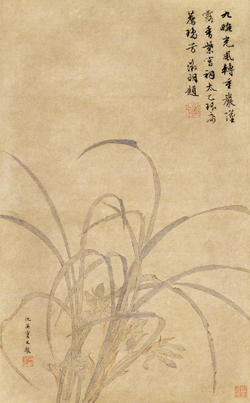One of the 'Four Ming Masters' QIU Ying 仇英 (1502-1552) created this orchid with great craftsmanship, a sensitive representational exercise of subtle colour and understated brushstokes. The outline of leaves is a simple, gently pulsing line of moderate grey. In its mild variation it suggests the life of the plant, and the play of an unseen, almost unfelt breeze. Here and there a slight tear in a leaf reveals observation while also pointing to the vicissitudes of life. Orchids are a conventional sign of the aloofness and perfection of literati gentlemen - in pre-greenhouse days this was a small flower of isolated mountain valleys.
The painting is complemented by the inscription of Qiu's contemporary and friend, WEN Zhengming 文徵明 (1470-1559). Wen's limpid strokes provides a delicate contrast to the crispness of Qiu's outlines.
The colour is now faded, the paper grey from exposure to smoke or incense. Literati connoisseurship took pleasure in such aging as it smoothed sharp impressions, with stains and decay indicating the gradual yielding of an artwork to the passage of time.
In his The Great Painters of China (1980), Harvard professor Max Loehr uses this painting (then in the Chiang Er-shih Collection) to represent Qiu Ying decribing it as 'a representation of timeless perfection.' A similar - but unsigned and un-inscribed - version of this motif is held in the Palace Museum, Beijing.
| | 
 |